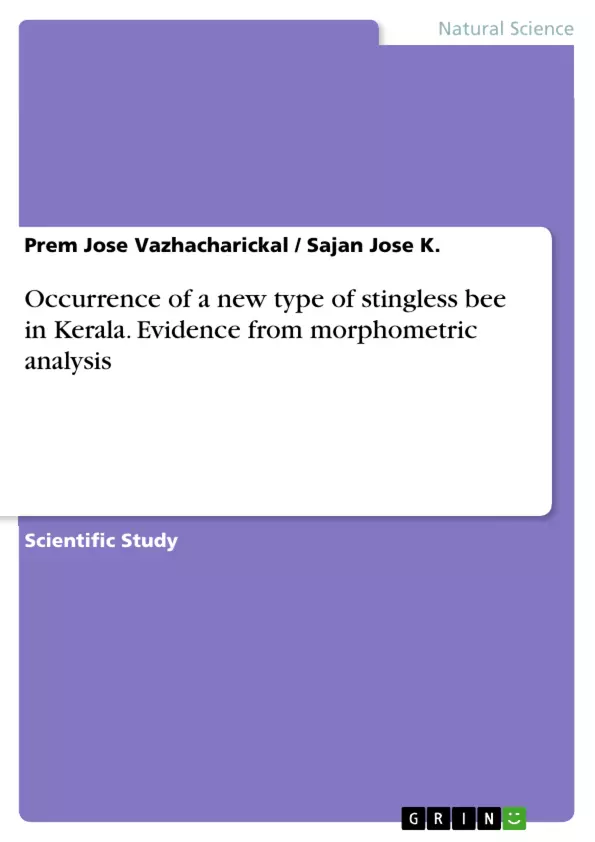Stingless bees are limited to tropics and subtropics with diversity in species and share morphological and behaviour patterns. Stingless bees are major pollinators of flowering plants in the tropics and improve crop productivity. Trigona iridipennis Smith were kept in India for centuries for the high medicinal value of honey as well as propolis and bee wax. A wide range of variations, especially worker and drone body size and measurement, were reported. Morphometric and geometric analysis provide a valuable tool for the differentiating variations among various honey bees and stingless bees.
Based on these back ground, our objectives of this study were 1) to characterize the morphometric aspects of workers in this reported new species of stingless bees and 2) to identify the various similarities and differences existing based on factor and principal component analysis with Trigona iridipennis Smith.
A total of 30 samples of workers were collected and various morphometric characters including head length (HL), head width (HW), proboscis length (PL), distance between two dorsal ocelli/lower intercocular distance (DBO), dorsal ocello-ocular distance (DOOD), antennal length (AL), thorax femur length (TFL), thorax tibia length (TTL), thorax metatarsus length (TML), thorax metatarsus width (TMW), thorax forewing length (TFWL), thorax forewing width (TFWW), pterostigma width (PtStW), pterostigma length (PtStW), hind wing length (HWL), hind wing width (HWW), number of hamuli (HAM), abdominal tergite length (AbTL), abdominal sternum width (AbSW), mandible length (MdL) and mandible width (MdW), head length width ratio (HLW), thorax metatarsus length width ratio (TMLW) and thorax forewing length width ratio (TFWLW) were analyzed.
One sample (SS1) showed distinct differences in habitat preference (Laterite rock), appearance (size and colour), behaviour (passive) and nest architecture (narrow round entrance tube, snow white brood, cream white food pots). The present study based on the morphometry of stingless bees across Kerala shows that, in spite of the morphological and behavioural variations exhibited by the bees, members of all samples belong to Trigona iridipennis. But one sample (SS1) shows entirely different morphometric characteristics. It was found that this sample belongs to genus Lisotrigona
Inhaltsverzeichnis (Table of Contents)
- Occurrence of a new type of stingless bees in Kerala: Evidence from morphometric analysis
- Introduction
- Materials and Methods
- Study area
- Study design and data collection
- Morphometric measurements
- Statistical analysis
- Results
- Descriptive analysis
- Correlation analysis
- Principal component analysis
- Discussion
- Conclusions
Zielsetzung und Themenschwerpunkte (Objectives and Key Themes)
This research aims to characterize the morphometric aspects of workers in a newly reported species of stingless bees in Kerala and to identify similarities and differences between this species and Trigona iridipennis Smith through factor and principal component analysis.
- Morphometric analysis of stingless bees in Kerala
- Comparison of the new species with Trigona iridipennis Smith
- Identification of morphometric variations among stingless bees
- Exploration of the relationship between body size and environmental factors
- Possible identification of a new genus of stingless bees
Zusammenfassung der Kapitel (Chapter Summaries)
- Introduction: This chapter provides an overview of the importance of stingless bees as pollinators and the challenges they face due to habitat loss, agriculture, and climate change. It also highlights the specific focus of the study, which is to investigate a potential new species of stingless bee in Kerala and its relationship to the already established Trigona iridipennis Smith.
- Materials and Methods: This chapter details the methodology used in the study, including the study area, sampling procedures, morphometric measurements, and statistical analyses employed. It describes the collection process of the bees, their preparation for morphometric analysis, and the use of various statistical techniques such as PCA to analyze the data.
- Results: This chapter presents the findings of the study, including descriptive statistics of the morphometric characters of worker bees, correlation analysis between different characters, and the results of the PCA. It highlights significant variations in morphometric characters across various samples of worker bees, indicating potential differentiation between the new species and Trigona iridipennis Smith.
- Discussion: This chapter discusses the findings in detail, emphasizing the relationship between body size, feeding habits, and environmental factors. It also explores the potential of the new species to belong to a different genus (Lisotrigona) based on the morphometric data and the characteristics of the nest architecture.
Schlüsselwörter (Keywords)
The key themes and concepts explored in this research include stingless bees, Meliponiculture, morphometry, Trigona iridipennis Smith, Lisotrigona, and the potential for a new genus of stingless bees in Kerala.
- Quote paper
- Prem Jose Vazhacharickal (Author), Sajan Jose K. (Author), 2016, Occurrence of a new type of stingless bee in Kerala. Evidence from morphometric analysis, Munich, GRIN Verlag, https://www.grin.com/document/349889



